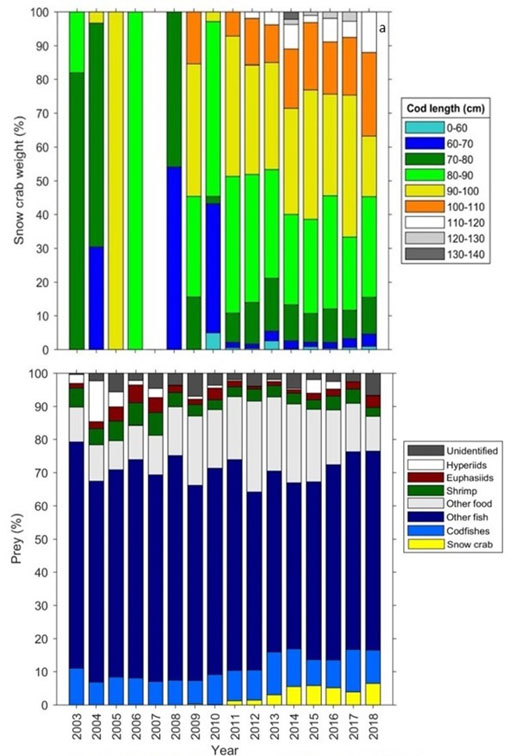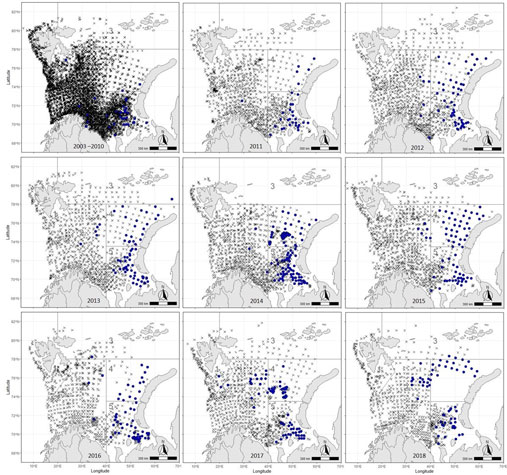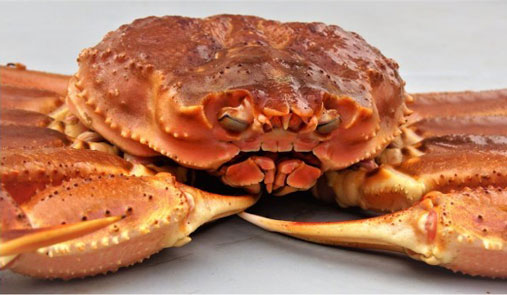The snow crab is a newly established species in the Barents Sea, increasing in both distribution and abundance in recent years. We explore the potential importance of Northeast Arctic cod predation in structuring the snow crab population expansion in the Barents Sea. To do this we perform statistical analyses on a unique cod stomach content database. We assessed patterns of snow crab within cod diet across years, spatially across the Barents Sea, between seasons, as well as trends with increasing cod size. We found that snow crab represents a new prey item for Barents Sea cod, increasing in diet contribution from 2003 to 2018. Medium to large sized cod (60-110cm) eat snow crab, mainly during the summer and autumn seasons. Our results support the idea that cod has the potential to regulate the snow crab population in the Barents Sea and is unlikely to compete with the snow crab fishery in the Barents Sea. We suggest that cod can be used as a biological sampling tool together with other monitoring programs.
The snow crab
Snow crab (Chionoecetes opilio) are large crustaceans (>10cm) that feed on other crustaceans like crabs, and snails on and within the sea floor (Fig. 1). In recent decades the native habitat of the snow crab has expanded from the Northern Pacific and North western Atlantic into the Barents and Kara Seas. The snow crab population has increased rapidly in both distribution and abundance across the Barents Sea.
The establishment of a large marine crustacean to the marine community could impact the entire Barents Sea ecosystem, through interactions with other species and competition for prey and resources.
The Barents Sea is home to several valuable fisheries, e.g. cod (Gadus morhua), capelin (Mallotus villosus) and red king crab (Paralithodes camtschaticus), and it is important for management to know how the snow crab’s expansion may impact these resources.
We know that the distribution of snow crab overlaps with cod’s in the Barents Sea and cod as a top predator has the potential to control its distribution and further expansion in the Barents Sea.
In our study we explore the potential for cod predation in structuring snow crab distribution and abundance in the Barents Sea. We use a unique long 35 year cod diet dataset (Holt et al. 2019; Townhill et al. 2021) to quantify how the snow crab establishment is reflected in the cod diet.
The proportion of snow crab in cod diet has increased over time

On average, it is the medium and large sized cod (60-110cm) that eat the most snow crab (Fig. 2 top). Snow crab was not present in cod diet prior to 2003 and since then has increased yearly to 2018 (Fig. 2 bottom).
Shift in spatial variation in snow crab present in cod diet
In recent years, the distribution of snow crab has shifted in a more northeasterly direction (Fig. 3).

We find that snow crab represents a new prey item food cod in the Barents Sea and has rapidly increased within cod diet since 2003. The increased proportion of snow crab in the cod diets over time is consistent with the increase in population also observed in snow crab fisheries landings in the Barents Sea. We suggest that cod has the potential to regulate the snow crab expansion and population increase. Furthermore, the use of such a comprehensive stomach content database (Townhill et al. 2021) represents a valuable resource in monitoring the expansion of newly established species such as snow crab. Thus we find that cod can indeed be utilized as a biological sampling tool together with other monitoring programs.
For more information and further detail please see the full scientific article and literature below.
References:
Holt, R.E., Hvingel, C., Agnalt, A., Dolgov, A.V., Hjelset, A.M. and Bogstad, B. 2020. Snow crab (Chionoecetes opilio), a new food item for North-east Arctic cod (Gadus morhua) in the Barents Sea. ICES Journal of Marine Science. Fsaa168
Holt, R.E., Bogstad, B., Durant, J.M., Dolgov A.V., Ottersen, G. 2019. Barents Sea cod (Gadus morhua) diet composition: long-term interannual, seasonal, and ontogenetic patterns. ICES Journal of Marine Science DOI: 10.1093/icesjms/fsz082
Townhill, B.L., Holt, R.E., Bogstad, B., Durant, J.M., Pinnegar, J.K., Dolgov, A.V., Yaragina, N.A., Johannesen, E. and Ottersen, G. 2021. Diets of the Barents Sea cod (Gadus morhua) from the 1930s to 2018. Earth System Science Data. 13: 1361-1370.

Log in to comment
Not UiO or Feide account?
Create a WebID account to comment